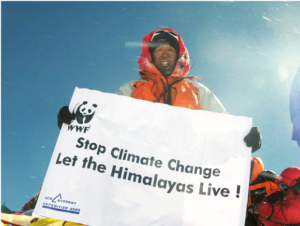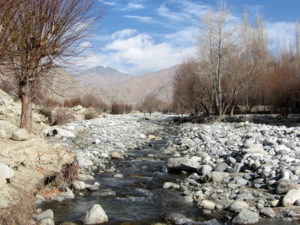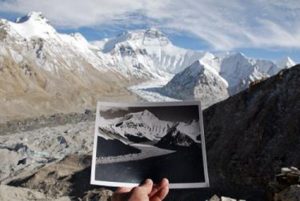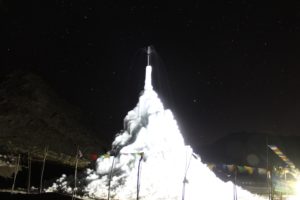
Photo: Climate4life
The Himalayas, which also translates to an ‘abode of snow’, is home to 9 out of 10 of the world’s highest peaks, including the mighty Mount Everest. Often referred to as the ‘Third Pole’, this region contains the greatest concentration of glaciers and permafrost outside the Polar Regions. Spanning eight countries, including Afghanistan, Bangladesh, Bhutan, India, Myanmar, Nepal, Pakistan and Tibet(occupied by Chinese) this rugged and high-altitude terrain is a source of livelihood for more than 210 million people and supplies water to a fifth of the world’s population ~ 1.3 billion. This 2500km belt plays a very crucial role in the Earth’s atmospheric circulation and the sustenance of its biodiversity.
But alas, this much touted ‘abode of snow’ might just be reduced to a figure of speech in the years to come. Global warming is having a severe impact on this region and its ecosystem, severely impacting the amount of snow, which in turn creates serious implications for downstream water resources. The most widely reported impact is the rapid melting of its glaciers. Almost 67% of the glaciers in the Himalayas have retreated. Also in line are major changes in the strength and timing of monsoon, inner high-pressure systems and winter westerlies – all bearing profound effects on the climate of the region.
More than 190 countries, as part of the Paris Climate Agreement, pledged to reduce their emissions in order to keep the increase in average global temperature below 1.5 degrees Celsius. Even then, this region might witness a substantial decrease in snowfall and a more than 33 percent increase in melt rates. The changes are already beginning to show. The Gangotri glacier, the source of the Ganga is receding at an average of 20-23 meters per year. At this pace, it wouldn’t be long before the glacier becomes history. The ICIMOD (International Centre for Integrated Mountain Development) reported rapid temperature increases in the high altitude region, as can be seen in Ladakh or places like Sikkim and Arunachal Pradesh beginning to witness their streams running dry each passing year. Climate Change involves serious changes in the magnitude and frequency of extreme weather events such as high-intensity falls causing flash floods and landslides. The impact of Global Warming on downstream water resources, groundwater levels, the overall ecosystem, as well as on its people, their livelihood and culture will be drastic – and ‘drastic’ might well be just a euphemism as the full extent of these changes might still not be realized.

Photo: Nivedita Khandekar
So the ever pertinent question still remains, ‘Will the Himalayas be able to survive the impact of Global Warming?’ Maybe. But first and foremost, something needs to be done to fill the severe gap in the knowledge of both the short and long-term implications of the impact of this Global Warming induced climate change on the Himalayas and downstream river basins. The establishment of monitoring systems for snow, ice, and water, application of hydrological models to predict water availability and the development of basin-wide scenarios taking into account water demand and socioeconomic development should be taken up with a sense of exigency. The HIMAP (Hindu Kush Himalayan Monitoring and Assessment Program) by ICIMOD has acknowledged the presence of these critical data gaps and hence is gearing up to produce a Comprehensive Assessment of the Hindu Kush Himalayan Region to address them. Another roadblock that needs amends is government programmes that largely neglect the importance of local communities. This approach has been found to be deeply debilitating. With their immediate existence also at stake, the participation of these communities becomes key to conservation.

Photo: Economist
Nevertheless, local communities and organizations are stepping up efforts to fight this change. One such example is the WWF’s year-long campaign ‘Climate for Life’, intended to bring the world’s attention to the impacts of global climate change in the Eastern Himalayas. Other examples include the ‘Climate Himalaya’ initiative which focuses on knowledge sharing, capacity building and climatic adaptation aspects in the Himalayan ecosystem. It has grown to become an important reference for governments, research institutions, civil society groups and international agencies working in the Himalayas.

Photo: Icestupa
The Monpa community in the Tawang and Wes Kameng districts presents a shining example of conservation efforts by local communities. Faced with the crisis of dying springs, the community started spring conservation and preservation efforts, such as the one outside the famous Tawang monastery in Tawang. Another example is that of artificial glaciers in Ladakh. SonamWangchuk, a mechanical engineer, and his team have built a huge cone-shaped block of ice known as the ‘Ice Stupa’ in Phyang, which is nine miles from Leh. During spring, the artificial glacier melts, giving free-flowing water to the community.
Another silver lining comes from a 2014 report by the IPCC (Intergovernmental Panel on Climate Change) admitting its previous miscalculations on the fate of Himalayan glaciers. It had estimated in its 2007 report that the icy reservoirs would disappear by 2035, but with the help of several monitoring systems, we now know that they will not disappear soon. That is not to say that they are not shrinking, but that there’s still some hope of saving them. For now, the onus is on us all to save them.

